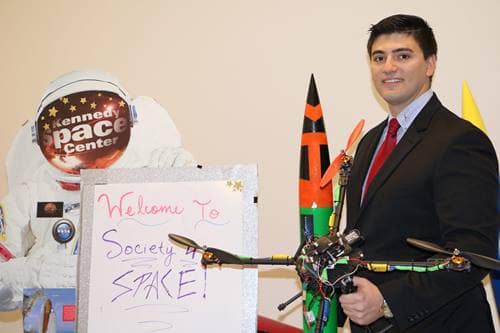 Degree Program: Aerospace Engineering with Minors in Flight and Space Studies
Degree Program: Aerospace Engineering with Minors in Flight and Space Studies
Year: I am a senior, 2013 to 2018 with graduation in December 201
How has undergraduate research impacted your life?
I have always been a very passionate person, especially when it comes to space. Even as a child, I felt this compulsion to read, know, and learn everything I could about spacecraft. I felt a strong inclination and demonstrated a natural ability for engineering work. I had a calling. I was going to be an Aerospace Engineer.
My career goals are to obtain a Master’s Degree in Aerospace Engineering. My professional educational objectives are ‘learn how to fly them’, ‘learn how to build them’ and ‘build them better and within the safety and environmental parameters required of today’s aerospace industry.' I want to create better and safer spacecraft that would ameliorate space travel. Five years from today I hope to be part of the merging generation of conscientious engineers who will lead in the development of new space transportation models that regards proper stewardship of technological innovation and environment. Ten years from today I expect to have helped develop spacecraft that would make interplanetary space travel a reality.
What does research mean to you?
Research is my life goal now. I do not enjoy working with old technology, researching and using the latest technology is the way to go.
Describe some of the projects you have worked on.
I have completed my Private Pilot, Instrument Rating and Commercial Single -Multi-Engine Certifications in Broward College. Presently, I am in my junior year in Embry-Riddle Aeronautical University working toward an Aerospace Engineering degree with a minor in Pilot Technology and Space Studies. In 2013, I was very fortunate to have been offered an internship position with InterFlight Global Corporation, a leading aerospace business development consultancy. My work experience at InterFlight Global introduced me to different matrixes that could be utilized to accomplish financially violable space research.
As President of Embry-Riddle S.P.A.C.E Club, two research projects were developed for the university: a weather balloon with a capability of performing scientific tests and a built in tracking/ data retrieve program and an Autonomous Recovery Vehicle attached as the payload for ERFSEDS rocket, that collects atmospheric data in its descent.
I have written a research publication on the “The Construction of a Level 2 NAAR Certificate Rocket." I have also lead the Embry-Riddle Math Club Research Project: Ballast Attitude Eco-Dolphins GPS & Sonar Communication System. I am assisting Dr. Sergey V. Drakunov, Embry Riddle’s Associate Dean for Research and Graduate Studies, with research work for NASA's Mars Reconnaissance Robot; and a steam propulsion system for a NASA STTR Phase 2 called WINE. I am completing a volunteer internship for Michael DuPuis, NASA Engineer and working with him on the Asteroid Free Flyer Prototype for a NASA STTR Phase 2.
I have helped designed a 3D-printed NanoLab Cube Structure for a payload for the Blue Origin New Shepard Rocket. The NanoLab Project called CRExIM (Cell Research Experiment in Microgravity) was lead by Dr. Pedro Llanos. This payload was sent to space on December 12th on board the Blue Origin New Shepard Rocket. The payload consisted of cancer research in micro-gravity.
